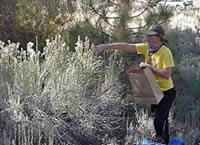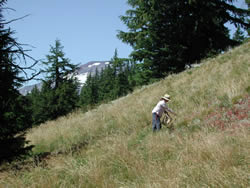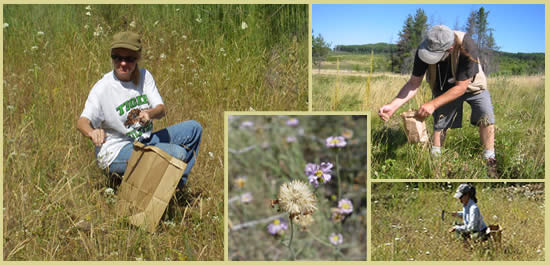USDA Forest Service Celebrating Wildflowers
|
|
|
 |
|
Developing Native Plant Materials for RestorationCollecting Native Seed
For many native species, collection of wildland seed is the first step in a lengthy process of making plant materials available for restoration projects. Successful seed collection involves planning ahead and monitoring for maturity. Suitable donor populations must be located and seeds must be collected at the appropriate time once they are mature. The window for collection is highly variable among species, ranging from only a few days to several weeks or longer. If the window is missed, collection must wait until the next year or growing season, at a minimum. Forest Service seed collections are made by volunteers, staff, and professional collectors under contract. Regardless of the method, supervisory controls are in place to ensure that collection sites are not located within off-limit areas, such as in Research Natural Areas, sensitive or federally listed plant sites, or other environmentally sensitive areas. Also avoided are collection sites occupied by invasive plant species.
For each target species, collection sites are located using guidelines that ensure a representative sample of genetic variation is obtained. The specific number and distribution of collection sites will vary according to size, density, continuity of populations, and biology of the species sampled, as well as the desired quantity of seed to be obtained. A general rule of thumb is to collect from a minimum of five collection sites at least 0.5-1.0 mile apart. A larger number of collection sites may be needed for inbreeding plant species to adequately sample genetic variation among populations. Within-population genetic variability is sampled by collecting from a large number of widely spaced or unrelated plant parents (30-50 or more plants is optimal). 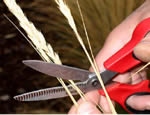 Seed collection methods will vary depending on the species. Grass seed is harvested by stripping or shaking it off the stem, or by clipping the stem with scissors or small scythes just below the spikelet. Shrub seed is picked or lightly beaten or shaken, using a tarp to catch the falling seed. For species that dehisce explosively, the entire inflorescence may be cut prior to maturity and allowed to dry in mesh or paper bags, or under netting. Ladders may be required for collecting seed from taller shrubs, or plants can be lightly pruned with telescoping pole pruners. For large-scale harvesting, specialty equipment and machines may be necessary. Whatever the method, collections should always be conducted in a manner that does not damage existing vegetation or other resources. Ideally, at least 50 percent of the seed crop at a given site is left intact to allow for natural recruitment and regeneration of the native population. 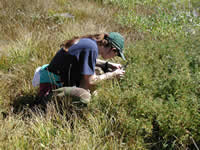 Close monitoring is required in order to match the timing of seed collection activities to the distribution of seed maturation. Multiple trips to a site may be required for determining when the seed is mature, and also for collecting. Collecting at multiple times throughout the maturation period can help prevent inadvertent selection against either early or late maturing genotypes. 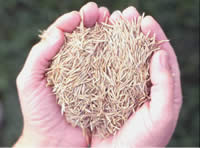 Seed must be collected and stored in such a way as to ensure its viability. Overheating can kill seeds, and excessive heat and temperature fluctuations should be avoided. High moisture content during storage can also cause seed damage and loss of viability due to molds. A good rule of thumb is the 100 rule of thumb, where the sum of temperature (degrees F) and relative humidity (%) does not exceed 100. Field collection forms and GIS are used to document collection area location, along with other important details such as collection dates and the number, distribution and health of parent plants. In some states, third party certification services are available for tracking seed source identity of wildland collections, as well as for ensuring genetic integrity during the field seed production cycle.
Additional Resources and References
|
|
| NOTE: PDF format links require the Adobe Acrobat Reader to view. | |
| top | Disclaimers | FOIA | Privacy Policy | Quality of Information | Photo Credits & Use |
Location: http://www.fs.fed.us/wildflowers/nativeplantmaterials/collecting.shtml
Last modified: Tuesday, 24-Jun-2008 21:54:53 EDT
